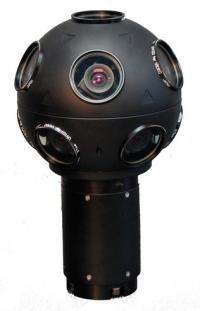February 27, 2008 weblog
Jump into the screen with 360-degree immersive video

As you watch a video, have you ever wondered what's happening beyond the camera frame? If you could jump inside the video and look around, you would have a 360-degree view of the world in your TV screen or computer monitor.
A company based in Calgary, Alberta, called Immersive Media Corp. is trying to achieve exactly this type of immersive experience with a new camera and software technology. When watching a video filmed with the Immersive Viewer (IMViewer) system, users can control the scene, seamlessly moving the perspective up, down, sideways, or even behind the original frame.
The technology is based on a Dodeca 2360 camera, which can record eleven image streams that are arranged in a geodesic geometry. The camera captures images at a resolution of more than 100 million pixels per second - significantly more than HDTV. The 20-pound camera also has four built-in microphones for simultaneous omni-directional audio recording. When recording, camera operators can check each individual lens to see what´s being recorded at every angle.
Immersive Media's software then turns the video files into "telemersion" files. A processor compresses, records, and synchronizes up to 12 channels at once.
Then, the videos can be viewed on computer monitors, video screens, head-mounted displays, or projected onto a dome screen. When watching video on a computer monitor, viewers use the mouse to turn the viewing in any 360-degree direction (demos available at Immersive Media's Web site). The viewing engine essentially blends camera image streams together in real time to make a movable window. With a head-mounted display, a viewer can see different angles simply by turning their head.
To enhance the immersion experience, viewers can also "direct" the video by rewinding, pausing, speeding up, slowing down, or zooming in on certain areas. The technology is also compatible with GPS or other metadata, enabling viewers to determine the location they´e viewing.
The software can also blend the entire 360-degree scene onto a single 2D screen, called a "sphere movie." These sphere movies show the whole environment in motion at once, without having to direct the field of view. Sphere movies can be watched on standard software such as Quicktime or Windows Media Player, or recorded on DVDs. They're also compatible with MPEG-2 and MPEG-4, and can be broadcast using HDTV-resolution channels.
With another feature, viewers can watch three frames on a single screen: the controllable video, the full sphere movie (with crosshairs that correspond to where you are looking in the controllable frame), and a GPS frame telling you your location as you move.
While Immersive's camera technology was developed three years ago, it was originally used by the FBI to study street routes of visiting dignitaries for security purposes. More recently, Google Earth has used the technology to create its StreetView videos. Immersive also hopes to use the technology for applications such as urban planning, oil and gas resource management, emergency response and first responder operations, and commercial media.
One notable company taking advantage of the technology is Adidas, which has featured videos incorporating the immersion capability on its Web site. Viewers can zoom in on their favorite basketball players and replay scenes to see reaction shots - in short, experiencing the event with a personal perspective.
More information: Immersive Media Demos





















